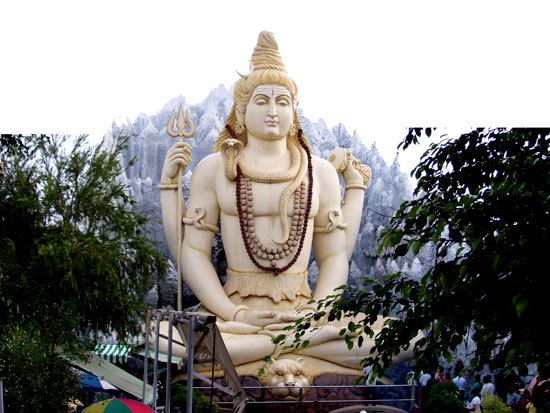Om Namasivaya
Significance of Maha Sivarathri:
by Panchamee Hewavissenti
[email protected]
 The beginning of the year 2008 was marked with the great spiritual
and cultural precursor - Thai Pongal, one of the greatest cultural and
religious festivals marked on the top of the calendar right after two
weeks of the beginning of the new year. The beginning of the year 2008 was marked with the great spiritual
and cultural precursor - Thai Pongal, one of the greatest cultural and
religious festivals marked on the top of the calendar right after two
weeks of the beginning of the new year.
The third month of the calendar doesn't remain insignificant for
Hindus to uplift themselves with spiritual blessedness, engaging in
religious and cultural observances.
Here comes another great spiritual festivity on March 6, Maha
Sivarathri - the great night dedicated to Lord Siva, who is Supreme to
Hindus. Maha Sivarathri is celebrated to mark the day on which Lord Siva
consumed Alakala Visham -the deadly venom to save the world. It is also
believed that on that day Lord Siva got married to Parwati.
According to the Hindu lunar calendar, Maha Sivarathri falls on the
14 day of the dark half, Maasi, from February to March. The night prior
to the new moon day, of every month has a special importance.
The new moon day is called Amavasya day according to the lunar
calendar. When we look in to Hindu mythology, twelve nights of the year,
one night each month is believed that goddess Parvathi incarnates a
mortal to worship her spouse Lord Siva.
Among all these 12 nights there is a very special night, the one that
falls in the month of Maasi is considered the most important day to
venerate Siva that is Maha Sivarathri. Many interesting connotations
around Mahasivarathri are weaved in Hindu mythology.
Once there was a controversy between deities Vishnu and Brahma about
their supremacy. Lord Siva tried his best to sort out that dispute by
becoming a huge fire - Amalagni.
He asked Brahma and Vishnu to find out his head and feet. Taking the
form of a swan, Brahma went in search of Siva's head and Vishnu in the
form of a huge boar, dug the earth to discover Siva's feet. Neither of
them was able to do that.
When Brahma went in the search, Ketaki flower -Thazhamboo in Tamil,
misled him to locate Siva's head. This triggered Siva's ire and he
cursed the flower to be the abode of a cobra. Then the flower fathomed
its folly and asked pardon.
Siva pardoned the flower and let it be used for his deification only
on the Maha Sivarathri day. Eventually the other two counterparts of the
trinity accepted their defeat and prayed to Maheswara. They were anyway
blessed by Parameswara, and were asked to continue their duty - creation
and protection without fighting over supremacy.
The auspicious one
The name Siva, bears the meaning of auspicious one. Siva, the
destroyer is considered one of the principal deities of Hinduism and
part of Hindu trinity including Brahma - creator and Vishnu - preserver.
It is also believed that the three spikes of the trident which Siva
holds in hand depicts three fold qualities of nature - creation,
preservation and destruction.
One of the conspicuous attributes of Lord Siva is the coiled cobra
around his shoulder and the neck. Hindus believe that it symbolises
Hindu dogma of reincarnation.
Cobra's natural process of malting skins denotes of human soul's
transmigration of bodies from one life to another.
Maha Sivarathri rituals
Those who have invincible faith in Lord Siva are called Sivaities.
Sivaities all over worship and glorify Lord Siva on that distinctive and
sanctified night of Maha sivarathri. Devotees do not waste that
auspicious night sleeping, because virtues of that significant night are
immense.
Devotees throng at temples dedicated to Siva on Maha sivarathri.
They pray and invoke blessings from Lord Siva with utter certainty
that the Lord will bestow on them a merriment life with spiritual
purification. On Maha sivarathri day, in addition to these six time
rituals, four special rituals will be conducted starting from 11.30.
p.m. to 4.00 a.m. The wee hour is the time for Lingodhbhava (birth of
linga). At 4.30 a.m. the Lord will be taken to Palliyarai - the rest
room in a shrine dedicated for deities.
Devotees keep vigil in order to get blessing from Lord Siva because
they believe that Siva grants their wishes they make on Maha Sivarathri.
Devotees will engage in religious observances among them the most
prominent practice is bathing 'Siva Lingam' every three hours chanting "Om
Namasivaya". They use milk, curd, honey and rose water to bathe 'Sivalingam'.
They offer sacred betel leaves where the goddess of prosperity -
Luxmi, is believed to reside. The house of a devotee can be seen shining
with great spiritual atmosphere on Maha Sivarathri day.
Hymns can also be heard which produce an euphonious melody. Hindus
believe that he who utters the names of Siva such as Mahesh, Parameswara,
Shankar, Bholenath, Neelakanth, Shambu Kailashehwar, Umanath, Natraj
etc, with absolute adoration will be freed from all sins. He is also
believed to reach the abode of Siva and live there with perfect devotion
and exult. The person will be released from the wheel of birth and death
in order to attain the supreme bliss.
The holy Sivarathri night comes to an end with the sunrise and the
devotees who observed the night with greater reverence will immerse
themselves in the temple tank known as `theertham' ending the vigil and
the fast. |
